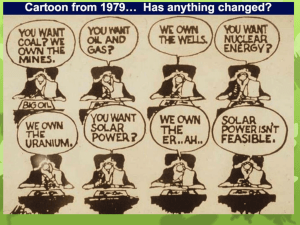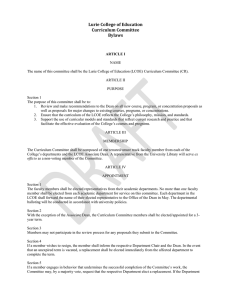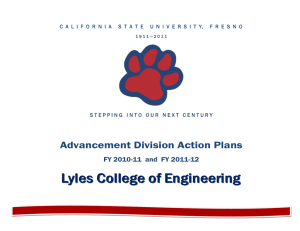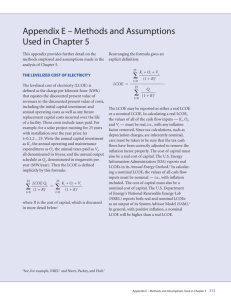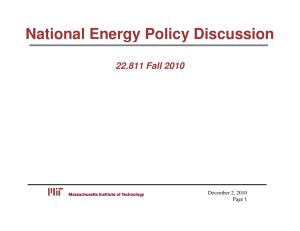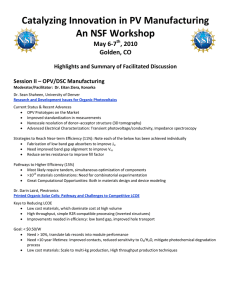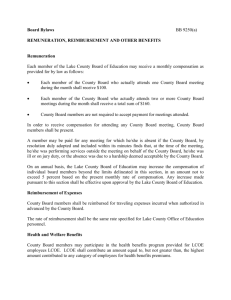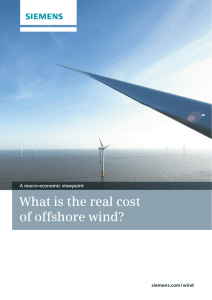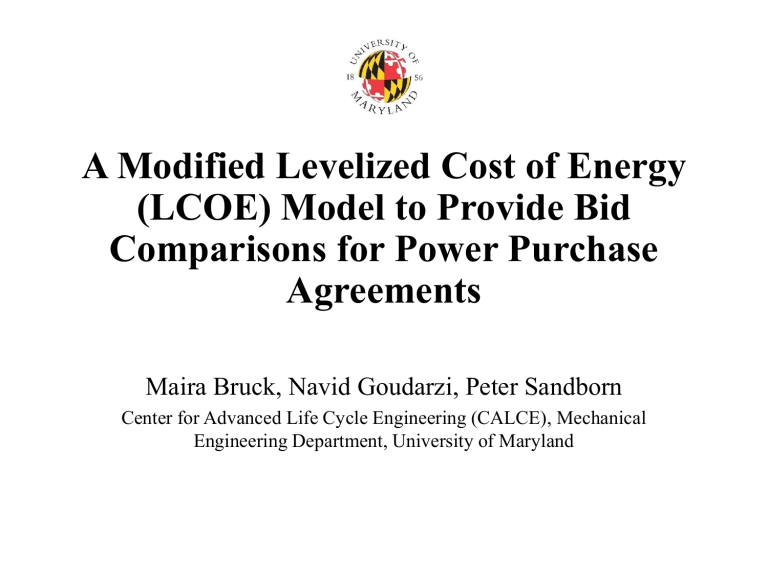
A Modified Levelized Cost of Energy (LCOE) Model to Provide Bid Comparisons for Power Purchase Agreements Maira Bruck, Navid Goudarzi, Peter Sandborn Center for Advanced Life Cycle Engineering (CALCE), Mechanical Engineering Department, University of Maryland Levelized Cost of Energy (LCOE) and Power Purchase Agreements Levelized Cost of Energy (LCOE): “The Total Life-Cycle Cost (TLCC) for each unit of energy produced in the given lifetime of a project.” Power Purchase Agreements (PPAs): • PPAs are performance-based contracts that aim to create a “fair” agreement for the purchase and sale of energy between a utility (the Buyer) and a generator (the Seller) – LCOE is commonly used within these energy contracts to determine a fair Cost of Energy (COE) • PPAs define under (minimum) and/or over (maximum) energy delivery limits and their penalties – Over production causes a loss as the energy will no longer be bought (or will be bought at a reduced rate) – Under production will cause the Seller to be charged a penalty The Problem with LCOE • Energy delivery limits in PPAs increase the LCOE through production loss and penalties, which should be considered costs – – – – Conventional LCOE calculations do not include the penalties An accurate LCOE is vital to ensure that the project breaks even and does not fail An LCOE that is too high might deter potential investors or Buyers in the PPA An LCOE that is too low hurts the Seller • In a bidding market for PPAs on a wind farm, either the wind farm or the utility bids a contract that presents an escalating (with “inflation”) price schedule or a constant price schedule – Utilities prefer an escalating price schedule because investors and utilities look at short-term returns instead of long-term returns – The wind farm needs an accurate LCOE to compare proposed price schedules in order to ensure that there is a similar total revenue from the escalating versus a flat price schedule • Creating a price schedule in which the final net revenue equals the net revenue from a constant LCOE (throughout the contract length) is generally not possible • Revenue has to be based on purchased energy, conventional LCOE is based on produced energy. Modeling LCOE The LCOE is the cost that, if assigned to every unit of energy produced by the system over the analysis period, will equal the total life-cycle cost when discounted back to the base year. New Model: Conventional Model: n CPEi i i 0 (1 r ) LCOE n Ei i i 0 (1 r ) n LCOE i 0 CPEi PN i PLi (1 r ) i n Ei i i 0 (1 r ) PN i Minlim Pexp Ei COEi PPA Penalties: PLi Ei Maxlim Pexp COEi Energy Production CPEi I i OM i Fi TCi CPE E r I OM F TC Maxlim Minlim PN PL Pexp COE = Cost to produce energy = Energy generated = WACC = Initial investment cost = Operation and maintenance cost = Fuel cost = Tax credit = Maximum Energy Threshold = Minimum Energy Threshold = Penalty cost = Production loss = Expected energy production = Cost of energy 75% of expected output Maximum Energy Threshold 52% of expected output Minimum Energy Threshold Annual kWh Output Annual Output 1 2 3 4 5 6 7 8 9 10 11 12 13 14 15 16 17 18 19 20 Year of Project Under PPA New LCOE Model Results The new LCOE model depends the capacity factor variation and the penalty “gap” (the difference between the minimum and maximum penalty thresholds). For a symmetric gap: Capacity Factor = 0.2 Half the time, the energy production is above or below the average production determined by the capacity factor by the variation specified 0.21 0.21 0.2 0.2 Annual Energy Output Variation: 0 10% 20% 0.19 Penalty Gap Size: 0 0.05 0.1 0.15 0.2 Infinite 0.18 0.17 0.16 30% 40% LCOE ($) LCOE ($) 0.19 0.18 0.17 0.16 0.15 0.15 0 10 20 30 40 0 0.05 Annual Energy Output Variation (%) Penalty gap size = Maxlim – Minlim E per year 8760(CF )( RP) 0.1 0.15 0.2 0.25 Penalty Gap Size I OM F TC r RP = $1500 per installed kW = $0.01 per kWh produced = $0 = $0.05 per kWh sold = 0.089 per year = rated power 0.3 0.35 0.4 Wind Farm Case Study Actual wind farm data shows that the LCOE without penalties (conventionally calculated LCOE) is lower than the actual LCOE that includes penalties. Different wind farms have different characteristics and the gaps in the actual LCOE can vary. Maxlim = 0.75 Minlim = 0.52 I OM F TC r = $1500 per installed kW = $0.01 per kWh produced = $0 = $0.05 per kWh sold = 0.089 per year • Farms differ and different contracts need to be constructed for them • The conditions in the farms determine the gap between the conventional LCOE and an LCOE that includes delivery penalties • In the PPA bidding market, the conventional LCOE could be problem (wind farms 1,2,3, and 6) Conclusions • By creating mechanisms to reduce the risk of higher costs for the Buyer, PPAs create a paradox of higher LCOEs for the Seller • The new LCOE model allows Sellers in a PPA to use expected future energy production to assist in negotiating penalties and an appropriate Cost of Energy in the PPA based on the expected costs from penalties • The optimal PPA should focus on an appropriate Minlim for projects with a low capacity factor and projects with a higher capacity factor can address having both limits or just one limit depending on the expected variation and the Buyer’s need for energy • Energy Markets Impact: The new LCOE model also allows for the Seller to compare contract bids with differing price schedules. This allows the Sellers to choose a price schedule that results in a final net revenue that is close to the net revenue from a flat price schedule.
